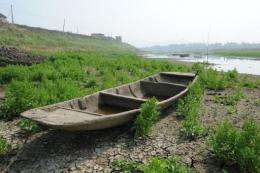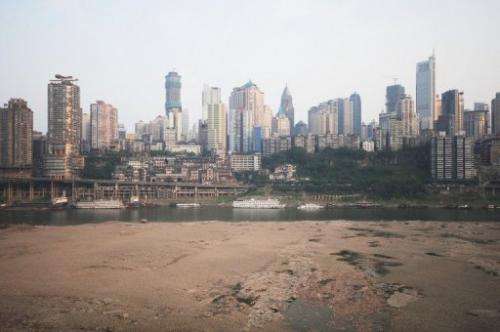A Chinese fishing boat sits on the dried-up banks of the Yangtze river, China's longest and most economically important river, in Wuhu, east China's Anhui province, on May 27, where water levels have been 40 percent lower than the average of the past 50 years.
A debilitating drought along China's Yangtze river has affected more than 34 million people, leaving farmers and livestock without water and parching a major grain belt, according to the government.
More than 4.23 million people are having difficulty finding adequate drinking supplies, while more than five million are in need of assistance to overcome the drought, the Civil Affairs Ministry said in a statement on Saturday.
"The special characteristics of this drought disaster is that it has persisted a long time," the ministry said.
"Secondly the losses to the agricultural and breeding industries have been severe... while drinking water for people and livestock have been seriously impacted."
Rainfall levels from January to April in the drainage basin of the Yangtze, China's longest and most economically important river, have been up to 60 percent lower than average levels of the past 50 years, it said.
"Large areas of farmland have been severely parched and cracking, making it impossible for early rice to take root," the ministry said.
The agricultural impact is likely to further alarm officials already trying to tame high prices, including grain prices which have been rising steadily on global markets in recent months.
Water levels in lakes and reservoirs mostly in the provinces of Jiangsu, Anhui, Jiangxi, Hubei and Hunan are close to historic lows, decimating fish farms, state press reports said.
The national flood and drought control authority has ordered the Three Gorges Dam, the world's largest hydroelectric project, to increase its discharge of water to alleviate the regions downstream, the China Daily said.
"If the drought continues and there is no rainfall before June 10, the dam will lose the capacity to relieve the drought," the paper quoted Wang Hai, an official with the corporation that oversees the dam, as saying.
According to the state meteorological station, no rains are predicted in the region until June 2.
Dried up bank of the Yangtze River is seen in southwest China's Chongqing municipality. The drought on China's Yangtze river has led to historically low water levels that have forced authorities to halt shipping on the nation's longest waterway, according to the government and media.
Already the Three Gorges Dam has had to cut back on electrical production due to the drought, while shipping along the river below the dam has been hampered due to the low water levels, media reports said.
The State Grid, China's state-owned power distributor, reportedly said this week that 10 of its provincial-level power grids were suffering severe shortages due to the drought's impact on hydroelectric generation, including Shanghai and the heavily populated southwestern Chongqing region.
China could face a summer electricity shortage of 30 gigawatts -- the most severe power shortfall since 2004, the company said.
China's north has been suffering from a lack of rain for nearly 15 years -- largely attributed to global warming -- while the south, especially the Yangtze river basin, has been prone to flooding during the annual summer rainy season.
Just last summer, sustained torrential rainfall across the region caused widespread flooding and landslides leading to the deaths of more than 3,000 people, state press reported.
(c) 2011 AFP
























